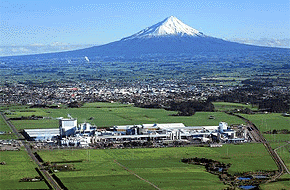
Content supplied by Dairy NZ
Dairying in Taranaki produced $1 billion worth of milk in the last financial year, reports industry body DairyNZ as it heads into the province next week for its Annual General Meeting (AGM) where it will report to farmers on its $60 million national levy investment strategy.
This is the first time DairyNZ has held an AGM in the province, and DairyNZ Board chairman John Luxton says Taranaki’s performance shows that “traditional dairying is alive and thriving in this country”.
“Milk production in New Zealand has grown around 50 percent in the last 10 years and reached 1.7 billion kilograms of milksolids in 2012. Traditional dairying regions, like Taranaki, are driving local economies.”
DairyNZ statistics report 490,500 cows in 2012-13 in the Taranaki province. “That’s 17 percent of the North Island herd and 10 percent of the national herd.
“Dairy farm amalgamation has not been as prominent a trend in Taranaki as in other areas and herd and farm sizes are therefore slightly smaller.
“The number of cows milked in Taranaki has been relatively steady over the last 15 years. Effective hectares have declined slightly, but this has been offset by a slightly higher stocking rate (2.8 cows/ha),” he says.
“The average herd size in Taranaki of 283 cows, run on 99 hectares, is below the North Island average of 332 cows per farm. But the industry is a power producer for the province.”
John Luxton says the Taranaki region produced 169 million kilograms of milksolids in the 2012-13 year, down three percent from the previous year due to summer drought. “Based on an average milksolids price of $6.50, the value of this production was $1.07 billion,” he says.
According to New Zealand Institute of Economic Research estimates, the dairy sector directly contributed 13 percent of Taranaki’s regional Gross Domestic Product (GDP) in 2012.
“This equates to $811 million of regional value added. The on-farm sector contributed $343 million, with the dairy processing sector contributing a further $468 million,” he says.
“Around half a dairy farmer’s milk production revenue is spent on farm working expenses and this is money that circulates in the community. The dairy sector also employs around 4,150 workers in the Taranaki region – around 8.6 percent of total regional employment. This excludes those self-employed of which it is estimated to be close to 2000,” he says.
John Luxton says DairyNZ is funded by a national levy on every dairy farmers’ milk production. The organisation will report to farmers on its investment activities and achievements at a meeting at The Hub in Hawera at 1.30pm on Thursday October 17. Four farmers are also vying for two farmer-elected director spots on the DairyNZ board and the election results will be announced at the meeting.
“New Zealand dairy farmers currently invest through their industry levy around $60 million per year on research and development, farm business management, industry information, biosecurity and on-farm environment work to improve our productivity and sustainability.
“Research is at the very core of DairyNZ’s business. New Zealand’s competitive and responsible ambitions are underpinned by a combination of scientific, commercial and farmer innovation. The research and demonstration farms in South Taranaki are a big part of that.
“Going forward our strategy for dairy farming is all about enabling competitive and responsible dairy farming. Our research is focussed on boosting profits while reducing environmental impacts. The Feed Conversion Efficiency Trial that identified the gene marker responsible for efficiently converting feed into milk is a good example of that,” he says.
“Taranaki is showing the way with responsible environmental stewardship too. Farmers are voluntarily investing an enormous amount of money and time to ensure waterways on the Taranaki ring plain are protected with fences and vegetation. Around $80 million has been spent on plants, fencing and contractors since the project began. To date, the regional council reports that farmers have completed 2,882km of new fencing and 1,463km of new riparian planting. That’s a fantastic achievement.”
Taranaki trends data
| Year | Herd numbers | Total cow numbers | Total hectares |
Stocking rate |
Average herd size (cows) | Average hectares/farm |
| 1992-93 | 2,587 | 438,838 | 174,677 | 2.5 | 170 | 68 |
| 1997-98 | 2,599 | 482,991 | 188,392 | 2.6 | 186 | 72 |
| 2002-03 | 2,152 | 484,324 | 183,240 | 2.6 | 225 | 85 |
| 2007-08 | 1,793 | 474,626 | 168,281 | 2.8 | 265 | 94 |
| 2012-13 | 1,734 | 490,528 | 172,521 | 2.8 | 283 | 99 |




We welcome your comments below. If you are not already registered, please register to comment.
Remember we welcome robust, respectful and insightful debate. We don't welcome abusive or defamatory comments and will de-register those repeatedly making such comments. Our current comment policy is here.